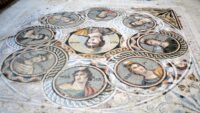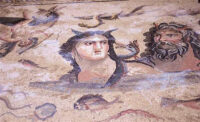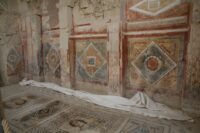 The House of the Muses, a Roman imperial-era domus decorated with elaborate mosaics and wall paintings, in the ancient city of Zeugma in southeastern Turkey’s Gaziantep province, will open to the public for the first time since it was discovered in 2007.
The House of the Muses, a Roman imperial-era domus decorated with elaborate mosaics and wall paintings, in the ancient city of Zeugma in southeastern Turkey’s Gaziantep province, will open to the public for the first time since it was discovered in 2007.
Built in the late 1st century, the villa was expanded and redecorated in the late 2nd, early 3rd century. It was destroyed by the invading Sassanids who sacked the city in 252/3 A.D., but its spectacular mosaic floors from the villa’s later period survived in excellent condition under the rubble fill. The house is named for perhaps the most specular of the mosaics: circular portraits of the Nine Museums bordered with geometric spirals and waves. Calliope, muse of epic poetry, is in the center circle.
 Another floor mosaic found in 2014 depicts the Titan Oceanus, the divine personification of the world-encircling river, and his sister/wife Tethys, mother of all the river gods. They both have wings sprouting from their foreheads, traditional attributes of the sibling spouses, and she bears a ketos, a dragon-headed snake, on her shoulder. Relatively rare in Greek iconography, the couple became a popular motif in the eastern Greek provinces of the Roman Empire between the 2nd and 4th centuries. In Zeugma, they appear in mosaics of luxury homes as symbols of marriage. The muses were also associated with marriage, as according to mythology they descended from Olympus to dance and sing at marriages of divinities/heroes like Cadmus and Harmonia and Peleus and Thetis.
Another floor mosaic found in 2014 depicts the Titan Oceanus, the divine personification of the world-encircling river, and his sister/wife Tethys, mother of all the river gods. They both have wings sprouting from their foreheads, traditional attributes of the sibling spouses, and she bears a ketos, a dragon-headed snake, on her shoulder. Relatively rare in Greek iconography, the couple became a popular motif in the eastern Greek provinces of the Roman Empire between the 2nd and 4th centuries. In Zeugma, they appear in mosaics of luxury homes as symbols of marriage. The muses were also associated with marriage, as according to mythology they descended from Olympus to dance and sing at marriages of divinities/heroes like Cadmus and Harmonia and Peleus and Thetis.
Earlier this year archaeologists revealed they’d found two symmetrical rock-cut chambers under 16 meters (52 feet) of fill. Flanking the east and west sides of the central courtyard, the chambers are hypothesized to have been dining rooms used to create an indoor-outdoor space for guests during all seasons.
Stating that the ancient city of Zeugma was one of the most important cities in Anatolia, especially on the Eastern Roman border, [excavation leader Professor Kutalmış] Görkay said that the excavations in the House of Muses, which have been ongoing since 2007, provided important information about the private lives, personal preferences and identities of the inhabitants of Zeugma.
“When we look at the places and the general structure of the house, we think that Zeugma belonged to a family having better than the middle-class economy. These houses may have one or two courtyards. Courtyards are areas where air and water enter, where rainwater is collected and used as water collection basins. In these wet areas, we see more water-related scenes. The courtyards of these houses were also used for dinner parties. The courtyards were filled with water, helping the house to stay cool during hot weather. The two rock chambers found here may also have been used as dining rooms. We are currently working on reinforcement. We aim to open them to visitors as soon as possible,” he said.
 Much of the ancient town was flooded when the Birecik Dam was built over the Euphrates in 2000. Out of the estimated 2,000-3,000 ancient houses in Zeugma, 25 are fully submerged now, and archaeological excavations have barely scratched the surface of what remains. The House of the Museums will be an important addition to Zeugma’s heritage attractions which feature the largest mosaic museum in the world with more than 18,000 square feet of mosaics salvaged from the city.
Much of the ancient town was flooded when the Birecik Dam was built over the Euphrates in 2000. Out of the estimated 2,000-3,000 ancient houses in Zeugma, 25 are fully submerged now, and archaeological excavations have barely scratched the surface of what remains. The House of the Museums will be an important addition to Zeugma’s heritage attractions which feature the largest mosaic museum in the world with more than 18,000 square feet of mosaics salvaged from the city.
I am constantly amazed by the artistic quality of mosaics such as we see here.
Look closely and you will see Oceanus does not have wings coming out of his hair but lobster claws. It is typical iconography for this titan.
Here are two more mosaics of Oceanus from Zeugma clearly showing the lobster/crab claws.
https://www.theoi.com/Gallery/Z35.3.html
https://www.theoi.com/Gallery/Z35.4.html
Another mosaic from Zeugma featuring Oceanus and Tethys showing the lobster/crab claws more clearly can be found